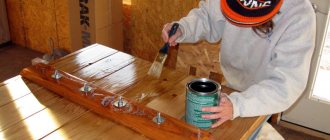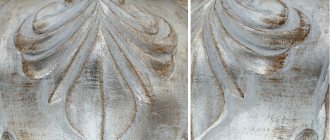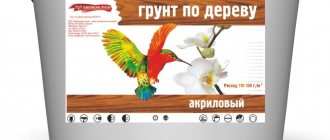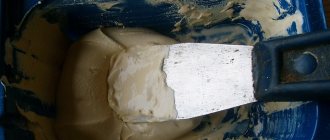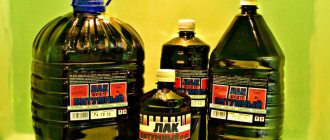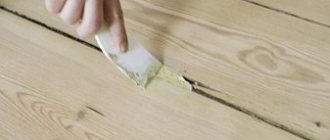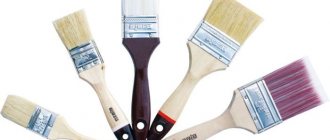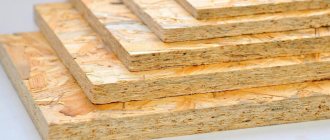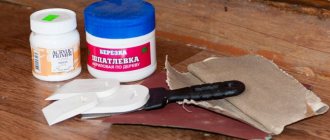Varnish allows you to renew a wooden surface that may deteriorate over time. Many people decide to paint the wood, but in order not to lose the appearance of the natural structure of the wood, it can be varnished.
The varnish coating protects the wood from moisture, mechanical stress, and atmospheric conditions. The products differ in composition, colors and technical characteristics.
How do the compositions differ?
Depending on the operating conditions of the wooden base, the varnish can be used indoors or outdoors. There are compositions that are quick-drying, odorless, frost-resistant, heat-resistant (fire retardant), water-based, oil-based or alcohol-based.
Varnishes come in the following form:
- in cans (aerosol, spray), which are convenient for covering small areas;
- in containers (cans, bottles), applied with a brush, roller, spray gun.
By purpose:
- floor varnishes (parquet);
- for decorating and emphasizing the structure of wood;
- for water transport.
General rules for choosing varnish
When choosing a varnish, we recommend following a number of simple rules:
- The varnish must be compatible with the material of the product. For example, not all acrylic varnishes adhere to metal. Any water-based varnish is not suitable for working with gold leaf.
- A high degree of adhesion of the varnish to the coating material must be ensured.
- It is necessary to take into account the conditions under which the thing you have made will be stored or used - indoors or outdoors, exposed to high temperatures or humidity, dust, etc. In other words, it is necessary to evaluate how the protective properties of a particular varnish are suitable for solving your specific problems .
- If the varnish performs a decorative function, then you need to clearly understand what result you want to get - glossy varnishes give glare, while matte varnishes retain the texture of wood or stone, making the material more durable and durable.
Varnish colors
The coating can be matte, glossy (with shine), semi-matte and semi-gloss. There are also high-gloss compounds for high shine.
- The most popular transparent varnishes on the market that highlight the natural structure of wood.
- It is possible to give the wood a beige, brown, red, or black color with a walnut shade.
- White varnish and mechagon color make the wood visually more voluminous.
- Tinting varnishes for wood darken the surface, hiding its imperfections. Used for wooden furniture and doors (including interior doors), parquet boards.
Varnishes from the manufacturer
The production of varnishes is one of the areas of production activity of the KrasKo Company . Our products include polymer varnishes for universal use (for concrete, wood, stone, brick, etc.).
Polyurethane varnish Tistrom
— one-component polyurethane-based varnish. The varnish is used for protective and decorative finishing of concrete and mosaic floors, screeds, paving and facing slabs, natural and artificial stone, decorative paving stones, borders.
Polyurethane transparent varnish Tistrom-Decor
- one-component glossy varnish. It is used for protective and decorative finishing of concrete and mosaic floors, screeds, paving and facing slabs, natural and artificial stone, decorative paving stones, borders.
It is also used as a finishing finish for self-leveling floors when sealing decorative chips and various patterns in order to increase the wear resistance of the coating.
Perchlorovinyl varnish Texol
— one-component varnish on a perchlorovinyl base. The varnish is designed to protect concrete, brick, stone, asbestos-cement and other mineral surfaces from corrosion.
Acrylic varnish Drevolak
— one-component acrylic-based varnish. The varnish is intended for protective and decorative finishing of wooden houses, facades, ceilings, pillars, fences, gazebos, garden furniture, ceilings, walls and doors.
Varnishes from the manufacturer - more information about the production of varnishes and polymer varnishes offered to your attention by the KrasKo Company
.
Types of varnishes by composition
The composition determines:
- characteristics of the mixture (drying time, coating thickness, presence or absence of odor);
- conditions of use (for external or internal work).
The price of paintwork depends on these factors, manufacturer and brand.
Oil varnishes for wood
- They are based on oils and resins.
- Dries in 1-3 days.
- Penetrates deeply into the rock.
- For interior work only.
- Process furniture or other wooden objects.
- Not suitable for floor coverings.
The proportion of oil content determines the period of complete hardening of the applied layer.
So, oil varnishes are:
- lean (oil content from 35 to 55%);
- average (from 55 to 65%);
- fatty (from 65 to 85%).
The more oil contained in the composition, the faster the drying, but the greater the susceptibility to wear.
Before applying with a brush, dilute the product to a comfortable consistency, since the mixture is initially too thick.
Artificial resins and oils are now used in production, which has reduced the price of the product. Previously, the composition contained natural oils.
Resin
An ideal alternative to oil based ones. The composition is based on the inclusion of synthetic resins (thermoplastic, thermosetting) and natural (amber).
Alkyd varnishes
They are produced on the basis of alkyd resins, with the addition of solvents (solvent or white spirit) and driers to accelerate drying. Alkyd mixtures are resistant to moisture and temperature changes. They are inexpensive, and their penetration properties into the rock are high.
The applied layer remains on the surface for two to three years. The period of complete polymerization is two days.
Suitable for wooden floors, floating floors, including heated floors, furniture. The compounds are toxic due to the solvent.
It is advisable to work in protective equipment (gloves, respirator).
They are divided into pentaphthalic (PF) and glyphthalic (GF). From the last category, GF-166 and GF-177 are popular. Both representatives have a transparent glossy sheen and harden after 48 hours (GF-177 is faster).
Alcohol
Alcohol varnishes (varnishes) have a narrow scope of application. The composition is based on the content of ethyl alcohol in which the resin is dissolved. This is a quick-drying varnish for wood. Dries in less than 1 hour (20-30 minutes), which is achieved by evaporating the alcohol after applying the layer.
Visually, alcohol mixtures are glossy. Used for coating musical instruments, furniture, leather, glass.
Alkyd-urea
Contains pentaphthalic or glypthal resins, urea. They are two-component and polymerize only after adding an acid-based hardener. Designed for interior work.
They give the surface a strong shine, the coating is highly durable and moisture resistant.
Can be applied to parquet boards or wood floors of any species. They cover indoor furniture.
Epoxy
This is a transparent composition that hardens after adding a hardener to the epoxy resin.
Epoxy varnish on wood is resistant to heavy loads, so it can be used on solid floors, parquet, and can be used to update interior doors or other wooden products.
The composition is moisture resistant and can be used for both interior and exterior work. Dries in half a day.
Polyester
These are multicomponent products based on the inclusion of polyester resins. It is applied with a special gun, so this option is not suitable for beginners. After complete drying, a transparent film of great thickness is formed, which ensures high strength and moisture resistance. Withstands high temperatures and exposure to chemicals.
Wooden musical instruments are usually processed.
Nitrocellulose
Nitrocellulose (or cellulose ether) varnishes contain organic thinners, cellulose nitrate, resins and plasticizers that improve characteristics.
Despite their high resistance to moisture, the mixtures do not withstand atmospheric conditions and do not have great mechanical strength. Over time, the film may peel off from the surface. It can be polished successfully and dries quickly (20-50 minutes).
There are both glossy (NTs-218) and matte (NTs-243) coatings.
Nitrovarnishes are toxic because they contain a solvent. You only need to varnish wood using a respirator and ventilate the room well.
After the solvent has evaporated, the applied layer is safe.
Not used for floors due to weak strength. It is often used to cover wooden furniture, pencils and music. tools. The varnish does not tolerate direct sunlight, so it is better not to use it outside.
Acrylic-urethane
This is a water-soluble, odorless varnish with high adhesion. After drying, the film is resistant to moisture, so you can cover wood in baths, saunas, and apply it in bathrooms. The coating is reliable and durable, does not affect humans, and is safe. It must be used at a temperature not lower than +12 °C, and stored at a temperature below zero, but not less than -5 °C.
Alkyd-urethane
Used as yacht varnishes.
Contains toxic substances (toluene and xylene), the fumes of which affect humans.
This is the best varnish for exterior woodwork, frost-resistant, waterproof, but smells bad. The coating lasts for about five years.
It is not recommended to use indoors. Even after drying, evaporation of substances may continue.
Polyurethane
There are one-component, two- and three-component varnish. The two-component product is prepared before use by mixing with a hardener. The three-component one also contains a solvent.
This is one of the most effective materials in terms of coating strength. But it takes a very long time to dry (2-3 weeks), with a strong pungent odor.
After drying, the layer is resistant to strong mechanical loads, moisture, any atmospheric conditions, chemicals. substances, creates anti-corrosion protection.
External and internal use. Polyurethane varnishes are popular for treating garden structures, yachts and boats, parquet boards, and walls.
Acrylic varnishes
Water-based acrylic varnish provides wood with effective fire protection due to the absence of flammable substances in its composition. These mixtures are odorless, safe for humans, and can be used for opening children's rooms.
They have high adhesion to wood and are vapor permeable, but their strength is not the highest. Water-based varnish is applied only to the primed surface and dries for up to 15 days.
Application is also possible on brick and concrete bases indoors.
Bituminous
Painting wood with bitumen varnish makes it resistant to moisture and acid-base environments.
By default it has a brown tint. The treated surface becomes visually pleasing.
It is applied in a thin layer, and small parts can be coated by dipping.
Tinting mixtures
You can paint a wooden door, furniture, parquet boards. Fulfills a protective and decorative purpose. Visually darkens the wood, giving it the appearance of expensive species, increases the strength of the base and protects against fungus and mold.
Food varnishes
Apply to wooden utensils that come into contact with food. There will be no consequences, the varnish is safe. Suitable for use on cribs and toys.
Specifications
More detailed technical characteristics of wood varnishes can be found in the table below.
| Varnish type for wood | Compound | Drying time | Application |
| Oil | Condensed drying or natural oils | 24–72 hours | Coating of furniture and other wooden products, excluding floors |
| Smolyanoy | Artificial and natural resins | 24 – 72 hours | Use similar to oil formulations |
| Acrylic | Acrylic dispersion, plasticizer, water base | 2–3 hours | Finishing of floors, reconstruction of wood products, external and internal work, including wet wood |
| Epoxy | Epoxy resin | 8–12 hours | Coating surfaces experiencing increased loads (wooden floors, doors, parquet) |
| Nitrolac | Cellulose nitrate, plasticizer, solvent, resins | 20–50 minutes | Musical instruments, pencils |
| Alkyd | Solvent, drier, alkyd resin | up to 48 hours | Furniture, parquet, floating floors |
| Alcoholic | Resin, ethyl alcohol | 20–30 minutes | Musical instruments, furniture |
| Polyester | Polyester resin | 3–6 hours | Surfaces that require a thick glossy film (for example, musical instruments) |
| Alkyd-urea | Urea, alkyd resin | From several hours to several days | Any types of wood coverings |
| Acrylic-urethane | Urethane, solvent, acrylic dispersion | 1–2 hours | Interior work (parquet, walls and floors of wooden houses or baths) |
| Alkyd-urethane (yacht) | Urethane, solvent, alkyd resin | 6–12 hours | Coating of ship surfaces |
| Polyurethane | Resins and hardener | 14–20 days | Coating of garden buildings, parquet, external and internal walls of wooden buildings, sea yachts |
What to consider when choosing
The mixture is selected taking into account the conditions of its use.
- Place of work. Indoors, compositions without toxic components and odorless during drying are selected. For external work, only wood varnishes with high resistance to weather conditions (precipitation, sunlight, frost) are suitable. It is permissible to use materials with an unpleasant odor outdoors.
- Wear resistance. Wooden floors and stairs must be coated with varnishes that have high strength and wear resistance. For furniture, you can choose less durable materials, for example, nitrocellulose.
- Toxicity. For indoor use, it is better to choose water-based mixtures. They are odorless, safe, and used without personal protective equipment. You can choose ones that contain toxic substances, but do not forget about a respirator and protective clothing.
- Drying time. If repairs need to be done quickly, water- or oil-based products may not be suitable. They dry out in up to two weeks. While alcohol and NC compositions dry out in 1-2 days.
- Shine. Matte or gloss does not affect the characteristics and quality of the varnish in any way. The choice depends on the person's preferences.
- Curing methods. Mixtures are divided into one-component ones, which are ready for application. And two-component ones, the drying of which begins after reacting with the hardener. It is better for beginners not to use two-component varnishes, since they need to work quickly and be able to maintain the proportions of mixing the components.
- The need for a primer. Priming the wood increases adhesion to the future paint and varnish material. Without preliminary priming, the dried layer may peel off prematurely. There are varnishes on sale with a pre-priming composition.
How to choose wood varnish
Any varnish used to coat wood is designed to protect the surface being treated from mechanical damage, exposure to moisture and sunlight, and processes of rotting and destruction. The choice of a particular material largely depends on its technical characteristics, composition and scope of use, so you should clearly understand which product is suitable in a particular case. When purchasing, it is recommended to pay attention to the following parameters:
- Wear resistance. Floor coverings place the highest demands on wear resistance. Polyurethane wood varnishes, which offer optimal protection against abrasion, are considered the most suitable for them. This category also includes acrylic-urethane and alkyd-urethane coatings.
- Gloss level. This parameter plays a significant role in interior design. Every living space contains objects with the same level of shine, so when purchasing, you should consider the similarity of the varnish with the overall design.
- Application area. If you are going to finish the interior, you need to buy wood varnish for interior work. If on the street - for outdoors.
- Drying speed. Each product has its own drying time, which varies from 20 minutes to several weeks. Water-based compounds dry the fastest, polyurethane ones take the longest.
- Fire safety. If interior work is carried out in wooden houses, it is advisable to choose paintwork materials with good resistance to high temperatures. In stores you can find a wide selection of flame retardant materials. They are more expensive than regular wood varnishes, but the cost of fire safety still does not compare with the costs that may be required to restore after a fire.
How to calculate varnish consumption for 1 m2 of wood
Average cost to cover sq. m. wood approximately 100-125 ml. The numbers are relevant for an ideal surface and are always individual.
Several factors affect consumption.
- Viscosity of the product. More viscous mixtures require more consumption. They are more difficult to apply; part of the solution remains on the bristles of the brush. Uniformity is also in question. The problem is solved by diluting it to a more liquid consistency. Water-based varnish is thinned by it. Other mixtures are diluted according to the instructions. Solvents are used.
- Wood surface. The finely porous base absorbs less material, which means consumption is reduced. The size of the pores depends on the type of wood and its age.
- Sanding quality. Cleaned, sanded wood is easier and faster to varnish and less material is required. Sand with a grinder and abrasive wheels or sandpaper with P100 grit. Better adhesion of the first layer to the second (with two-layer application) is ensured by sanding it, for example, with P220 grain.
- Application method. The spray gun reduces consumption, but it is important to maintain the required viscosity of the product. Excellent for processing large areas. A roller or brush is wasteful, the layer is thicker, and part of the paint and varnish material remains on the pile.
You can correctly calculate the required amount of mixture for varnishing wood experimentally. Buy a small container of the product and treat 1 m2 of surface with it. After complete drying, with a satisfactory result, you will know the exact consumption. You can reduce it using the tips above.
Exterior varnish
From the point of view of the final result, materials for external coating are not much different from wood varnishes for interior work. However, when choosing compositions for exterior finishing, it should be taken into account that any outdoor surfaces require higher protection from moisture, mold and rot. For this reason, the best option would be products that, after application, form a water-repellent and vapor-permeable film:
- yacht;
- oil;
- alkyd;
- acrylic.
Another criterion for choosing a varnish for wood is its resistance to ultraviolet rays. The influence of the sun is one of the main reasons for the rapid wear of coatings, since in the process of burning out the compositions quickly lose their protective characteristics. Therefore, when choosing a material, it is necessary to give preference to products with special additives that increase the resistance of paint and varnish coatings to ultraviolet radiation.
Oil varnishes
Oil varnishes are solutions of natural or artificial resins in vegetable oils (linseed oil is used most often) with the addition of solvents and driers (accelerators of the curing process). It should be noted that the slower the varnish dries, the stronger the coating, and the elasticity of the varnish depends on the amount of oil contained in the varnish; the more oil there is, the more elastic it is.
Rosin, amber, and shellac are used as natural resins. Often, in order to save money, natural resins are replaced with synthetic ones: phenol-formaldehyde (very toxic), alkyd, etc. Due to their low weather resistance, oil-based varnishes are used only for interior decoration, for example, to add shine to a worn wooden floor. Oil varnishes are widely used in oil painting, as well as in the manufacture of musical instruments.
How to work with wood varnish correctly, technology
The optimal conditions for applying wood varnish are dry, windless weather with temperatures not lower than +10 °C. It is best if the humidity level is no higher than 80% and the temperature is from 15 to 35 °C. Before you begin surface treatment, you should prepare a mask, gloves and safety glasses. Suitable accessories are required even if the work is carried out outdoors and the material is non-toxic.
| Buy |
Application of the compositions involves several successive steps:
Selecting a tool
. For coating, brushes, a roller or a spray gun are usually used. Brushes with natural bristles are suitable for applying oil-based varnishes, while brushes with synthetic bristles are suitable for obtaining a smooth surface. Rollers are relevant if you need to cover a large area. Spray guns are considered the most convenient tool that can be used to treat not only facades and fences, but also hard-to-reach places.
Surface preparation
. To achieve good adhesion of wood varnish, the surface should be prepared. To do this, the old coating (if any) is removed from it, and the cracks and cracks are filled with putty. Next, the wood is cleaned of dust and sanded with sandpaper.
Primer
. Surface priming is not always used, but it can make the surface smoother and reduce material consumption. Primer compositions are selected depending on the characteristics of the paintwork material and the wishes for the final result. In particular, for water-dispersion varnishes, an aqueous or acrylic primer is used, and to increase the wear resistance of wood, an alkyd primer is used.
Applying wood varnish
. The processing process itself begins with the preparation of the composition and its dilution with a solvent (if necessary). Next, the first layer is applied, and the varnish is applied in stripes on the horizontal surface, and in cross movements on the vertical surface. After processing, you need to wait until the material dries, then sand the coating with fine-grained sandpaper and apply a second layer. If necessary, after the composition has dried, the wood is covered with another 1–2 layers.
With the right choice of varnish for coating wood and following the rules for its application, you can achieve a perfectly smooth and aesthetic surface, well protected from the effects of the external environment.
Nitrocellulose varnishes
Nitrocellulose varnishes (nitrovarnishes) are solutions of cellulose nitrite in organic solvents. Often, alkyd, amino-formaldehyde and other resins are introduced into the composition to adjust the performance properties.
A distinctive feature of nitro varnish is its rapid drying. In case of thickening, the nitro varnish is diluted with a solvent. Most often, nitro varnishes are used for varnishing wooden products, but in some cases they can be used as a final layer on a metal surface.
Varieties depending on components
Based on their components, matte varnishes are divided into the following types.
Cured by UV rays
Most often it is a matte varnish for furniture or other wooden bases. The main advantages are non-toxicity, quick drying and high strength. The downside is the need for special equipment for drying. It is used in industrial furniture production, but is rarely used in household work.
Acrylic
Matte acrylic varnish has increased strength and resistance to solvents, helping to preserve the original color of the product for a long time. Can be used for interior and exterior work. Acrylic varnish is excellent for polymer clay.
Nitrocellulose
Dries quickly and is easy to apply. When using it, no additional equipment is needed. Disadvantage: it is poorly resistant to temperature changes and humidity; it can only be used for interior decoration. As a rule, it is used to cover various decorative wooden objects.
Polyurethane
Recommended for professional finishing work. Matte polyurethane is very durable, but you need to carefully choose the color of the varnish - with prolonged use, the surface may acquire a yellowish tint. If you choose polyurethane parquet varnish, it is recommended to pre-paint the parquet in the desired color, and then use matte parquet varnish, but without a tint color.
What it is?
This composition is a mixture of synthetic resins and natural solvents. The components of the varnish provide it with a high level of adhesion and resistance to moisture.
The quality requirements for alkyd products establish certain standards that the composition must meet - first of all, the varnish must be colorless and form a glossy or matte protective layer on the surface. Some products may have a certain shade. The mixture allows you to increase the aesthetic appeal of the base, emphasizing the depth of color, which is important, for example, for a parquet floor.
As a result of use, the treated surface becomes more attractive. However, the choice of a particular product should be based on personal preferences and the area of use of the surface. Alkyd varnishes differ somewhat in their specificity and chemical content, depending on whether they are used for interior or exterior use.
Alkyd mixtures are widely in demand in comparison with their analogues. This is due to the performance properties of the products, which are several times higher than the existing indicators of oil compositions.
Perchlorovinyl varnishes
Perchlorovinyl varnishes are solutions of polyvinyl chloride resin in organic solvents, with the addition of components that improve the properties of the varnish. Such varnishes dry quickly enough, have good mechanical properties and water resistance. Perchlorovinyl varnishes are used as protective coatings for concrete, reinforced concrete, brick and other surfaces. The disadvantages of perchlorovinyl varnishes include their low heat resistance and poor gloss.
And, in conclusion, some general recommendations for the use of varnishes:
- It is better to apply two thin layers of varnish than one thick one
- Each new layer of varnish increases the weather resistance of the coating
- in a wooden floor, instead of putty, you can use a mixture of varnish and sawdust to seal the gap
- Most solutions of two-component varnishes (for example, epoxy) are toxic, so when working with them you should use a respirator, goggles and rubber gloves, and the room must be well ventilated
In any case, when purchasing varnish in a store, you need to carefully read the instructions for its use and operating conditions.
Epoxy varnishes
Epoxy varnishes are solutions of epoxy resins in organic solvents. The film-forming element in epoxy varnishes is epoxy resins ED-16 and ED-20. Before use, a hardener is added to epoxy resins according to the recipe. Epoxy varnishes have high water resistance, mechanical strength, and adhesion to various materials. In everyday life, epoxy varnishes are often used to prepare putties and make souvenirs. Epoxy varnishes are often used for final finishing of metal surfaces.
Properties of impurities
To simplify the application process in alkyds, manufacturers use a solvent that evaporates (within 9-12 hours), forming a solid film.
Favorable conditions for this process: air temperature 18-20 degrees, humidity – 50%!
Areas of use
Alkyd varnishes are widely used for painting various surfaces. This material is used to cover:
- End parquet. The texture of the wood is preserved on the base painted with this coloring material.
- Warm floor. The composition of the material retains the original appearance of the base even with sudden temperature changes.
- Floating floor. Alkyd varnish tolerates mechanical and vibration loads well.
- Many types of metals.
Pros and cons of alkyd coatings
Advantages of alkyd compositions:
- The materials are resistant to changes in temperature and humidity.
- When using this varnish, the cracks and planks do not stick together.
- This material saturates wood well.
- The dried base has a matte or shiny surface.
- The coating is resistant to interaction with chemicals.
- This material protects wood from fungal formations and flowering.
But alkyd varnishes used for wood also have disadvantages.
- takes a long time to dry;
- have a pungent odor;
- If the application technique is not followed, the film may wrinkle;
- service life 3 years.
Classification of alkyd-based materials
The types of these paints have different characteristics, purposes and components.
Varieties of such compositions:
- two-pack;
- alkyd-urethane;
- matte and glossy;
- yacht;
- for metal.
Differences by components:
- water-based;
- two-component.
The final result of the painted surface:
- dullness;
- glossiness;
- semi-matte;
- semi-gloss.
Two-pack
Alkyd substances of this type have 2 components: varnish and hardener (drier). They are mixed in the required proportions before starting work. This mixture is used for 8 hours.
Apply two-pack materials in 1-2 thin layers.
The advantages of this coating:
- high water resistance and hardness;
- wear resistance.
Flaws:
- specific smell;
- instability to sunlight.
Alkyd-urethane
This type of varnish contains not only alkyd resins, but also urethane components. To dilute the mixture, use an organic solvent.
This wood varnish is applied to a new or previously painted base. The quality of the composition exceeds conventional mixtures with an alkyd base. In addition to the properties applicable to all types of such material, there are advantages:
- Short drying time. If the technology is followed, the paint material dries in 6-12 hours.
- Wear resistance to abrasion.
- Tolerance to temperature changes.
- Resistance to air humidity.
When urethane components are added to the coloring mixture, its service life increases. The cost of parquet varnish corresponds to the quality.
Flaws:
- high toxicity of the composition;
- susceptibility to fire.
If work is carried out in a dry room at elevated temperatures, the surface to be painted should be protected from drafts. Otherwise, the coloring material will dry unnaturally and become covered with cracks.
Matte and glossy compositions
Matte compositions are more practical. Small defects and dirt are not noticeable on their texture.
Glossy mixtures are difficult to maintain, but look brighter. This floor varnish reflects light and is recommended for use in dimly lit rooms.
Alkyd yacht
Yacht alkyd varnish is suitable for painting surfaces that are in constant contact with water. Wooden ships are treated with yacht composition.
Yacht composition is not used as a varnish for wood indoors due to its toxicity. It is not recommended for use on parquet or furniture.
Alkyd varnish for metals
Positive characteristics of coating for metals:
- After treatment with such impurities, the surface becomes shiny.
- The coating protects the base from corrosion and makes it resistant to moisture and temperature changes.
- It is used both indoors and outdoors.
Application method: aerosol. The use of brushes and rollers is acceptable. Before painting, the surface is cleaned of dirt, degreased, puttyed and treated with a primer.
Tips for working with varnishes
Before carrying out paint and varnish work on wood, the surface is prepared for painting.
Such work includes:
- Major repairs to damaged parts.
- Removing the previous layer.
- Cleaning the tree.
- Sanding (along the wood grain).
- Repeated cleansing.
- Primer.
- Sanding with fine sandpaper (zero) to bring the surface to a smooth state.
Recommendations for varnishing a wooden base:
- The material is applied in a thin layer 1-2 times, maintaining intervals for setting and drying.
- The room in which painting work is carried out must be well ventilated.
The varnish consumption is 50-75 g.m2.
Polyurethane and urethane varnishes
As a result of the chemical reaction between isocyanates and compounds containing several OH hydroxyl groups, high molecular weight resins are formed - polyurethanes. Varnishes based on polyurethane resin currently best meet modern requirements for paints and varnishes. They have exceptional mechanical strength, impact resistance and wear resistance and have good adhesion to metal, plastic, wood and concrete. Polyurethane varnishes are used for expensive products, primarily parquet and furniture. There are also special polyurethane varnishes for protecting stone, concrete floors, floor tiles, and facing bricks.
Alcohol varnishes
Alcohol varnishes are solutions of natural resins (shellac, mastic, sandalwood) in wine or wood alcohol.
Alcohol varnishes have good mechanical strength, are highly polished, but are not moisture resistant. Due to the high rate of evaporation of alcohol and the low rate of dissolution of resins, several layers of varnish can be applied without destroying the previous ones.
Due to the high cost of natural raw materials, the use of alcohol varnishes is limited. They are used to make high-quality musical instruments and toys.

